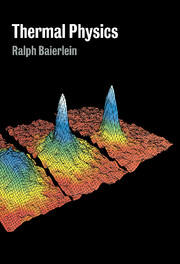Book contents
- Frontmatter
- Contents
- Preface
- 1 Background
- 2 The Second Law of Thermodynamics
- 3 Entropy and Efficiency
- 4 Entropy in Quantum Theory
- 5 The Canonical Probability Distribution
- 6 Photons and Phonons
- 7 The Chemical Potential
- 8 The Quantum Ideal Gas
- 9 Fermions and Bosons at Low Temperature
- 10 The Free Energies
- 11 Chemical Equilibrium
- 12 Phase Equilibrium
- 13 The Classical Limit
- 14 Approaching Zero
- 15 Transport Processes
- 16 Critical Phenomena
- Epilogue
- Appendix A Physical and Mathematical Data
- Appendix B Examples of Estimating Occupation Numbers
- Appendix C The Framework of Probability Theory
- Appendix D Qualitative Perspectives on the van der Waals Equation
- Index
5 - The Canonical Probability Distribution
Published online by Cambridge University Press: 05 June 2012
- Frontmatter
- Contents
- Preface
- 1 Background
- 2 The Second Law of Thermodynamics
- 3 Entropy and Efficiency
- 4 Entropy in Quantum Theory
- 5 The Canonical Probability Distribution
- 6 Photons and Phonons
- 7 The Chemical Potential
- 8 The Quantum Ideal Gas
- 9 Fermions and Bosons at Low Temperature
- 10 The Free Energies
- 11 Chemical Equilibrium
- 12 Phase Equilibrium
- 13 The Classical Limit
- 14 Approaching Zero
- 15 Transport Processes
- 16 Critical Phenomena
- Epilogue
- Appendix A Physical and Mathematical Data
- Appendix B Examples of Estimating Occupation Numbers
- Appendix C The Framework of Probability Theory
- Appendix D Qualitative Perspectives on the van der Waals Equation
- Index
Summary
If we know the temperature of a system and the values of its external parameters, how can we estimate its physical properties, such as energy, pressure, magnetic moment, and distribution of molecular velocities? The question is answered in this chapter: we derive the canonical probability distribution, learn some techniques for applying it efficiently, and work out two major examples.
Probabilities
Probabilities enter into thermal physics because the available data are insufficient to determine the individual properties of 1020 molecules. Moreover, even if such finely detailed data were available, no person or computer could cope with it. Out of necessity, one turns to a statistical analysis. A handful of data and some plausible reasoning lead to predictions whose success is nothing short of astonishing.
Before we look at what a “probability” means, we should note that probabilities always arise in a context. For example, the probability of a 4 appearing, given that I roll a die once, is 1/6. The probability of a four appearing, if I were to count the number of letters that come in my daily mail, would be quite different. Sometimes the context is made explicit; at other times, it is left implicit; but always there is a context.
- Type
- Chapter
- Information
- Thermal Physics , pp. 89 - 115Publisher: Cambridge University PressPrint publication year: 1999

